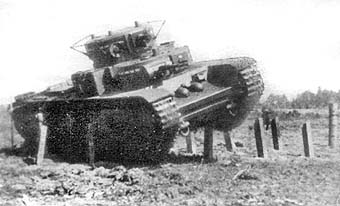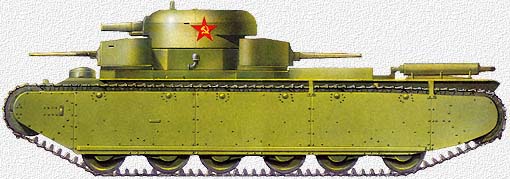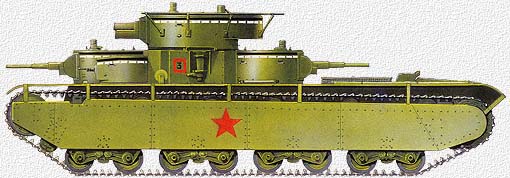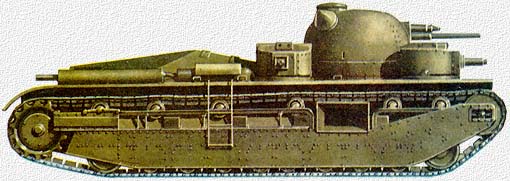| The T-35 Heavy Tank |
|---|
|
|

| The T-35 Heavy Tank |
|---|
|
|

In December 1930, the USSR had undertaken work to develop a new breakthrough heavy tank, the T-30. This work began after the signing of an agreement between UMM RKKA and the General Design Bureau of the Artillery Department.
The first proposals were for a 50-ton vehicle armed with a 76-mm gun and five machine-guns. However, a lack of experience with such vehicles hampered the finishing of a plausible design - even on paper! At the beginning of 1932, the first sketches and a wooden prototype were created, but the T-30 project was canceled due to design problems (almost insuperable problems with running gear) which appeared during its development.

Another attempt was undertaken by the Auto-Tank-Diesel Section of the Economic Department of the OGPU. This was a special section that employed tank designers convicted during the Purges. As in the previous case, this project had too many serious problems and was also abandoned.
 The T-35-1 on parade in Moscow. May 1, 1933. |
Only foreign specialists could get the project off the ground. In March 1930, a small group of German engineers led by Edward Grotte arrived in the USSR. This group was assigned to the Special Design Bureau AVO-5 in Leningrad in the "Bolshevik" Factory. AVO-5 had already worked on the TG-1 project. As far as I understand, the TG-1 was intended only to teach Soviet engineers how to develop a heavy vehicle, it was not intended as full-functional production vehicle. In August 1931, when the TG-1 was completed and tested all the German engineers were repatriated from the USSR. The AVO-5 was then reorganized.
The New design bureau was issued a directive by UMM RKKA: "By 1 August 1932, a new 35-ton heavy tank based on the TG-1 must be developed and built." The new project received the "T-35" designation. On February 28, 1932, G.G. Bokis (Deputy Chief of the UMM RKKA) was reporting to M.N. Tukhachevsky: "The work on the T-35 is going briskly, and should be completed on time."
On August 20, 1932, assembly of the very first prototype under the T-35-1 designation had been completed, and on September 1, it was shown to a special commission of the UMM RKKA. The tank made an impression on all the members of the commission. Outwardly, the T-35 looked like the English A1E1 "Independent" five-turret tank. Many people believe that the T-35 was copied from the "Independent", however, the Russian Archives have no documents, which can confirm such conjecture. Without such documents, we have no right to suspect Russian developers; the question is still open.
 The T-35A on trials. |
The main turret was supposed to be armed with a powerful 76.2 mm PS-3 tank gun and one DT machine-gun, but because of a lack of PS-3 guns, a dummy gun was mounted instead. Later, the shortage of PS-3s remained, and the 76.2 mm KT Tank Gun used instead.
The transmission of the T-35-1 had been developed with experience gleaned from the TG-1. It consisted of the M6 petrol engine, the main friction clutch, the gearbox and side clutches. Driving the tank was quite easy due to a well-designed pneumatic system.
Tests conducted in the autumn of 1932 revealed some defects in the transmission. Moreover, it was too complex and expensive for mass production, and all work on the T-35-1 had been canceled and the vehicle sent to Leningrad as a study aid for tank corps trainees.
In February 1933, new work on the T-35-2 began. As per Stalin's order, standardization of tank turrets for the T-28 and T-35 was implemented. On the T-35-2 the new M-17 tank engine, a new gearbox, and an improved transmission were installed. All other parts were the same as on the T-35-1. This tank was also intended to be arm with the 76.2 mm PS-3 gun. The vehicle was completed in April 1933, and on May 1, it was shown on military parade in Leningrad while the T-35-1 was shown on parade in Moscow.
Both the T-35-1 and the T-35-2 were prototypes. Almost simultaneously, the first production model, the T-35A, was developing using experience from these prototypes. In May 1933, the Soviet Government ordered mass production at the KhPZ Factory. All documents and the T-35-2 prototype were sent here. The T-35A had many changes, which distinguished it from its predecessors. The new vehicle had a longer chassis, smaller turrets, an improved hull, and some other alterations. In essence, it was a new vehicle, and so it had some teething troubles during its manufacture. I wish to notice, each T-35 was unique, since minor improvements were made in every tank, and therefore they were not true production vehicles because they didn't pronouncedly follow the base blueprints. Different parts of the T-35 manufactured at different factories: - Armored hulls at the Izhorskij Factory; According to the production plan, all these factories should have started manufacture in June 1933, but due to unforeseen problems, they began in August 1933. Final assembly began on October 18, 1933, and was finished on November 1. The final assembly was usually aided by using hydraulic lifting jacks, but in this case, the hull was placed on an elevated assembly jig in order to install the final components such as the running gear, turret, and armament. The first production T-35A was put on parade in Moscow on May 1, 1934. Per a Governmental order of October 25, 1933, the KhPZ had to complete five T-35A tanks and one T-35B (with an M-34 engine) before January 1, 1934, but up to this date only one vehicle had been fully completed. The other three T-35A's were still unarmed, and the manufacture of the T-35B had not even started. The T-35B project was later abandoned at all. The production of the T-35A was extremely expensive: a single tank cost 525,000 rubles - as much as nine BT-5 light tanks. This was definitive reason why its manufacture was cancelled. According to the plan of 1934, the KhPZ had to produce ten vehicles (T-35A). During production, the factory made some changes to cut production costs. However, factory engineers met with many problems. For instance, the tracks of the tank were too fragile, and the M-17 engine often overheated. The first vehicle had to be completed on August 20, 1934, but was not. However, the KhPZ built ten by the very end of 1934. |
In 1937, the T-35 was modernised. Its gearbox, side clutches, electrical equipment, the drive shaft, and the oil tank were improved. In addition, engine silencers were installed inside the vehicle. Due to these changes, the reliability of the T-35 increased greatly. However, the armor protection of the T-35 did not meet the demands of modern warfare, but because the vehicle was already too heavy, it was unrealistic to increase its armor any more. In 1937, the KhPZ began a plan to convert the T-35 to conical turrets. Production of the new tanks began at the end of 1938. According to KhPZ's records, total five tanks received conic turrets. Total production included one T-35-1, one T-35-2, and 61 production vehicles. The T-35 was the only production five-turret tank in the world. |
The layout of the T-35 was optimal for a multi-turret vehicle. Five turrets were set up in two tiers and provided high firepower with one 76.2 mm gun, two 45 mm 20K guns, and three machine-guns. However, such a layout resulted in an excessive vehicle height (about 3.5 metres) and decreased its mobility on the battlefield. In addition, the T-35 still had many problems with its engine and transmission. Unfortunately, these defects weren't fully eliminated, but Soviet tankers still held this vehicle in high regard. |
Outwardly, the T-35 was visually stunning with its huge dimensions, however its internal space was very cramped. When I visited Kubinka I was unable to get inside the T-35 (I'm 192 cm). The separate combat compartments were not connected with each other. Visibility from the vehicle was very bad, especially from the driver's position (he could see straight ahead and left only). However, the greatest problem was egress from a knocked out tank because the crew could escape only from roof hatches, and the crew from the main turret had to expose themselves at a 4-metre height under enemy fire. The driver was in an even worse situation: his hatch could not been opened until the machine-gun turret rotated out of the way. If this turret was jammed, the driver couldn't escape at all. Escape from the rear turrets was also difficult due to the rounded antenna on the main turret. The tank crew could become "prisoners" of their own tank. The first production T-35's were sent to the 5th Heavy Tank Regiment RGK. On December 12, 1935, this regiment was reorganized into the 5th Separate Heavy Tank Brigade. |
The brigade consisted of three Tank Battalions, one Training Tank Battalion, and some support units. On May 12, 1936, under the order of the Defense Minister, this brigade was attached to RGK. The unit was formed to increase the support of infantry and tank troops during breakthroughs of heavily-fortified defense lines. Deployment of the T-35 revealed its poor maneuverability. For example, one T-35 commander reported: "The tank was able to pass only a 17° slope. It couldn't even traverse a large puddle." The following directive was addressed to the headquarters of the 3rd Heavy Tank Brigade RGK and regulated the crossing of bridges: "1. For single-span bridges - only one vehicle at a time; |
Before the Great Patriotic War, the T-35 didn't take part in any military conflicts. Any mention in Western (and some Russian) accounts about T-35's that served in the Winter War are false. On 27 June 1940, a conference opened in Moscow: "On Weapons of AFVs of the Red Army." During debates, a question concerning the T-35 had arisen. Some officers thought that all T-35's should be converted to heavy self-propelled artillery (like the SU-14), others wanted to give all the T-35's to military academies. Interesting, almost nobody raised an opinion to keep them as vehicles of the first line. |
However, due to the active reorganization of tank forces of the Red Army, and the formation of the new mechanized corps, it was decided that these vehicles "should be depleted by attrition in operational units." As a result, all vehicles were collected in the 67th and 68th Tank Regiments of the 34th Tank Division of the 8th Mechanized Corps (Kiev Special Military District). Today, only one T-35 survives. It is on display in the Kubinka tank museum. |




| Parameter | A1E1 "Independent" |
|---|---|
| Crew, men | 8 |
| Weight, kg | 31 500 |
| Armament | 1 x 47 mm gun 4x7.62 mm TMG |
| Armor, mm | 13-28 |
| Engine | "Armstrong-Siddley", 398hp |
| Max. speed, km/h | 32 |
| Range, km | 320 |




|
Proof-reader:
Mark Jaremco Sources: M.Kolomiets "The T-35 heavy tank", 1995 M.Baryatinsky "Soviet tanks in the Second World War", 1995 "Bronekollektsiya" #2 1995 |